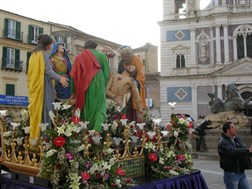The Vare of Holy Thursday in Caltanissetta
 At the end of the eighteenth century, the Holy Thursday procession of CaltanissettaOf ancient origins, Caltanissetta has linked its name to the Moncada of Paternó, the powerful aristocratic family who ruled the city for more than four centuries, until the abolition of feudalism in Sicily (1812). Like other cities in Sicily, Caltanissetta also was involved in an anti-Savoy revolt in 1718, only to spend a few years later, as the rest of Sicily, under Bourbon rule. was organized by the Congregation of Saint Philip Neri. The vara is the term by which the Sicilians call artistic pageants or wagons used to transport the relics and statues of saints and the Virgin Mary, as well as the statuesque scenes of the Passion (the Misteri). The word, which evidently comes from the word “coffin”, by extension indicates the entire processional on which the sacred bodies are placed (of Christ, the Virgin Mary and the saints) and the depictions of the Way of the Cross.
At the end of the eighteenth century, the Holy Thursday procession of CaltanissettaOf ancient origins, Caltanissetta has linked its name to the Moncada of Paternó, the powerful aristocratic family who ruled the city for more than four centuries, until the abolition of feudalism in Sicily (1812). Like other cities in Sicily, Caltanissetta also was involved in an anti-Savoy revolt in 1718, only to spend a few years later, as the rest of Sicily, under Bourbon rule. was organized by the Congregation of Saint Philip Neri. The vara is the term by which the Sicilians call artistic pageants or wagons used to transport the relics and statues of saints and the Virgin Mary, as well as the statuesque scenes of the Passion (the Misteri). The word, which evidently comes from the word “coffin”, by extension indicates the entire processional on which the sacred bodies are placed (of Christ, the Virgin Mary and the saints) and the depictions of the Way of the Cross.
The Holy Thursday procession of Caltanissetta, known originally as the Casazza (a term of Ligurian origin, which in ancient times in Sicily was used to designate the representations of the Passion of Christ), has, over time, taken the name of the procession of the Vare or Misteri. At the beginning of the twentieth century, the Mysteries were 15: the Last Supper, the Agony in the Garden, the Arrest of Jesus, the Sanhedrin, Ecce Homo, the Condemnation of Jesus, the First Fall, Simon of Cyrene, Veronica, Calvary, the Deposition from the Cross, the Pietà , the Translation to the tomb, the Sacred Urn, Desolation. The Vare of Holy Thursday were made of wood, papier-mâché and plaster, from the second half of the nineteenth century and early twentieth century. In the following years have been revised and increased, with up to 16 models: 14 depicting scenes from the Passion, in addition to the Sacred Urn and the statue of Our Lady of Sorrows. Today, the Vare are entrusted to associations and guilds (only three of which belong to the Real Maestranza), which also take care of the floral arrangements. On Thursday evening the groups gather in Piazza Garibaldi and depart in procession to the tune of the bands, and then return and separate (with the rite of the Spartenza). The sacred procession parades through the centre of the city from dusk on Holy Thursday to the early hours of the following morning. In the procession of the Vare a crucial role is played by the lighting (obtained with torches and artistic lanterns), the poignant singing of the faithful (which the Sicilians call ladata or lamintanza) and other elements that distinguish the classes and the workers.
A Museum of the Vare is currently under construction. Meanwhile, the Misteri of Caltanissetta can be seen at dawn on Holy Thursday, before the start of the procession, in some parts of the city, where they are placed to be decorated.
